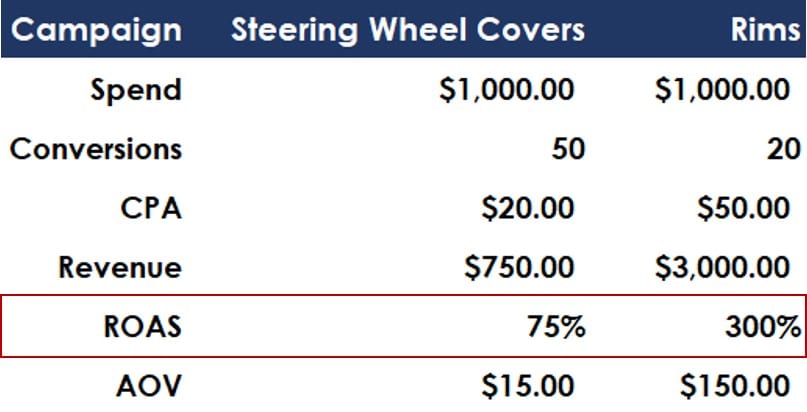“How is my account doing?” How you answer depends on the goals you set. There are many ways to attribute success to a campaign, but return on ad spend (ROAS) is one of the most popular due to its focus on the value the ad campaign drives.
What Is ROAS?
ROAS is the amount of revenue you earn for every dollar spent on advertising. You can calculate it using a simple formula:
revenue / cost = ROAS
For example, if you spent $100 on ads and earned $300 in revenue, then your ROAS is 3:1 or 300%.
When to Use ROAS as Your Goal
ROAS differs from ROI, return on investment. ROI focuses on the return for your business as a whole, where ROAS focuses on the return of a particular campaign or ad.
If you know that you need to make $3 for every advertising dollar spent, calculating the ROAS helps you determine where your paid search dollars are best spent.
Let’s take a look at two campaigns and see how we would shift our spending based on our campaign goal.
Goal: Conversions

Looking at the data above, we see that the Steering Wheel Covers campaign drove 50 conversions compared to the 20 driven by the Rims campaign. If we just focus just on the number of conversions coming in, we would want to place the majority of our advertising dollars in the Steering Wheel Covers campaign.
Goal: CPA
Let’s now shift our focus to a CPA — cost per acquisition — goal for the same two campaigns.

Based on the data above, we would still say that the Steering Wheel Covers campaign is performing more strongly because the CPA is $30 less than that of the Rims campaign.
Goal: ROAS
Now let’s factor in revenue, which we need to calculate ROAS:

The picture is radically different when we focus on ROAS. The Steering Wheel Covers campaign might have more conversions at a cheaper cost per conversion, but we aren’t earning positive revenue on that campaign. Instead, we should shift our focus to selling as many rims as possible.
ROAS: Not Just for Ecommerce
Most ecommerce businesses focus on ROAS because they can easily track the revenue from purchases on their website. But you can also use this metric for companies who need to generate more leads.
For example, a plumbing company could assign different values to a request for a quote, a phone call, and a completed request for maintenance form. With a value in place for each goal, you can optimize the campaigns to focus on acquiring the types of leads that result in the most revenue.
One of Many Metrics
One final note: In today’s digital world, marketing works holistically. So be careful not to focus solely on one key performance indicator (KPI) as the end-all, be-all number that determines whether that marketing method works or not.
With the continued iterations to Apple’s Intelligent Tracking Prevention affecting conversion tracking, as well as cross-device tracking limitations and people finding out about companies on Google and purchasing on Amazon, you have to be careful you don’t get tunnel vision by focusing on one metric and ignoring all others.
While counterintuitive, solely focusing on ROAS (or CPA or any other metric) in paid search can stall growth and hurt a business’s overall bottom line. ROAS should be one of several KPIs to evaluate results, but not the only one.
It’s easier to decide how and what to advertise when you know your business goals. Keep ROAS at the top of your list of goals to maintain a focus on the value your paid search campaigns drive.




